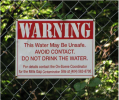In a perhaps unintended act of irony, U.S. Environmental Protection Agency representatives offered bottled water, chocolates and rubber squeeze balls in the image of the Earth to neighbors of the contaminated former CTS site during a Sept. 9 community meeting.
Don Rigger, a key official from the Region IV office in Atlanta, apologized for the agency’s past mistakes and assured the long-suffering neighbors of the Mills Gap Road site that it will be cleaned up — though he stopped short of saying when.
Rigger, who is chief of the Superfund Remediation and Site Evaluation Branch, told some 30 residents gathered at the Skyland Fire Department that whether CTS or the federal government ends up footing the bill, the pollution at the former electronics plant will be cleaned up. (In 1999, Rigger, then a section chief, told residents that the EPA would launch an investigation to determine the contamination’s source and to consider Superfund status for the site, according to an Asheville Citizen-Times report from Aug. 25 of that year.)
Addressing Dot Rice, whose property adjoins the site, Rigger said, “I’m sorry this has happened.” The Rice family’s spring, which once provided their drinking water, was contaminated with high levels of toxic chemicals, including trichloroethylene, a suspected carcinogen. The family was switched to city water in 1999, but by that time they’d been unwittingly consuming the tainted well water for years.
Despite the lack of details, local activist Tate MacQueen says he’s willing to take the EPA officials at their word. Rigger asked residents to be patient and give his agency more time to evaluate the site for inclusion on the National Priorities (Superfund) List. Evaluation and testing around the site have been under way since at least 1991.
The EPA can compel those responsible for Superfund sites to either get them cleaned up or reimburse the government for doing so. In the wake of the discovery of toxic waste dumps such as the notorious Love Canal in the 1970s, the federal program was established in 1980 to address abandoned hazardous-waste sites. It was originally funded by fees levied against polluters, but under the Bush Administration, the financial burden was shifted to taxpayers, according to a Government Accountability Office analysis completed in 2004.
MacQueen gave a carefully detailed, two-and-a-half-hour presentation reviewing his findings, including agency letters, lab-test results, video shot on-site and an interview with a former CTS employee that spells out the nature of the contaminants released. Tate’s presentation also charted precisely what different officials at various local, state and federal agencies knew at which points in the ongoing saga. A panel of eight agency officials listened attentively as MacQueen provided evidence of agency mistakes and failures to act.
Carolyn Callihan, remedial project manager for the site, accepted from MacQueen a complete copy of the original, first-phase evaluation, completed around 1999. MacQueen maintains that key pages — documenting improper waste-handling practices at the plant and the specific toxic chemicals involved — have been missing since a contractor first delivered the report to the EPA. MacQueen, who says he tracked down and replaced the missing pages himself, showed how the EPA had mislabeled other elements of the investigation, including the site’s correct address. This error resulted in the Rice family’s property being declared the toxic-waste site, although the source is now generally believed to be the CTS facility.
The Elkhardt, Ind.-based CTS operated an electroplating facility on the site from 1959 to 1986, then sold most of it to Mills Gap Road Associates. About 10 years later, the local partnership sold all but about 9 acres to the Biltmore Group, which built Southside Village, a residential development, on the property. The remaining acreage is vacant and fenced off.




Activated Carbon is listed as an excepted treatment technology for reducing trichloroethylene sourced in the EPA’s National Primary Drinking Water Regulations. Carbon block water filters use activated carbon but are constructed to give water more surface contact time with the carbon in order to remove higher levels of contaminants. No one filter system can do everything; so when building a treatment system to protect your family be sure to include quality carbon block filters for reducing your exposure to trichloroethylene and other VOC’s.